In whiplash charts. For example, department store sales soared 23% “seasonally adjusted” but collapsed 42% “not seasonally adjusted.” What gives?
By Wolf Richter for WOLF STREET.
We had another mind-twister this morning when the media proclaimed that in January retail sales “burst higher,” after the opposite had happened in December, when the media bemoaned the third month in a row of dropping retail sales.
But these are “seasonally adjusted” retail sales, and the seasonal adjustments in December and January are always huge. “Not seasonally adjusted,” retail sales collapse by about 18% to 22% every January during the merchandise-return binge (returns are negative sales) after December’s holiday shopping binge. So I noted a month ago that the massive “seasonal adjustments” in December had gone awry and that Americans had not actually cut back but had splurged in a record manner, documenting this with charts that showed both “seasonally adjusted” and “not seasonally adjusted” retail sales.
And in January, seasonal adjustments went awry again, but in the opposite direction, sort of balancing out December’s “seasonally adjusted” debacle. And then there was maybe a small-ish added oomph of the stimulus checks.
“Seasonally adjusted,” which is what you read in the media this morning, retail sales in January jumped by 5.3% from December, to $568 billion.
But “not seasonally adjusted,” retail sales plunged by 17.3% in January from December, to $510 billion. That plunge was not quite as deep as the normal December-January plunge of 18% or more. And compared to January last year, retail sales were up 5.8%, after December’s year-over-year increase of 4.3%.
Green = “seasonally adjusted” retail sales; note the dip in December and the rise in January. Red = “not seasonally adjusted” retail sales; note the record spike in December that I’d pointed out a month ago, and now the plunge in January:
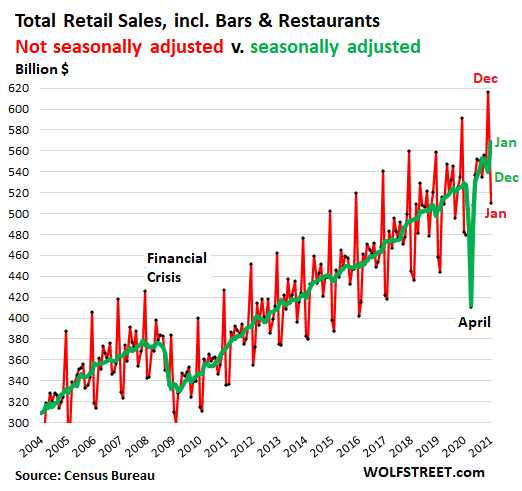
All this “seasonally adjusted” and “not seasonally adjusted” data was released by the Census Bureau this morning.
Sales at ecommerce sites and other “non-store retailers” (mail-order operations, stalls, vending machines, etc.) in January, seasonally adjusted, jumped 11%.
In December, these seasonal adjustments had gone awry, showing a 5.8% decline from November. But “not seasonally adjusted,” sales in December blew through the roof and hit a huge record of $112 billion, with an enormous spike from November, and were up 19% year-over-year, which I pointed out in my analysis back then.
In January, with the flood of merchandise returns, “not seasonally adjusted” sales plunged 29.5% to $79 billion. So seasonally adjusted sales jumped 11%; not seasonally adjusted sales plunged 29.5%. That’s how huge the seasonal adjustments are. And when they go awry just a little, it makes a big difference.
But year-over-year, sales in January were up 22%. And the ecommerce boom continued unabated in December and in January – there is no sign, as was alleged a month ago, that Americans cut back in December:
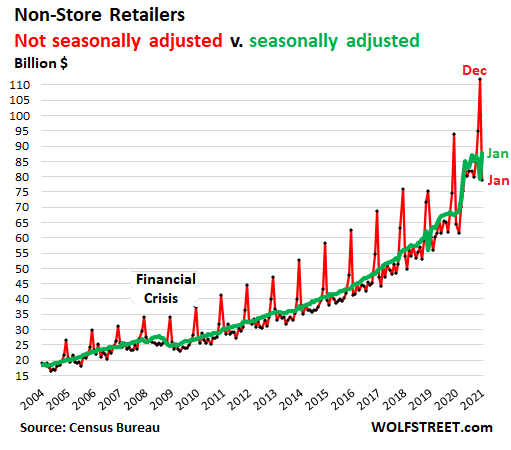
Sales at new & used auto dealers and parts stores rose 3.1% in January from December, seasonally adjusted. “Not seasonally adjusted” sales plunged by 11.9% from December, to $103 billion, but was up 10.4% from January last year:
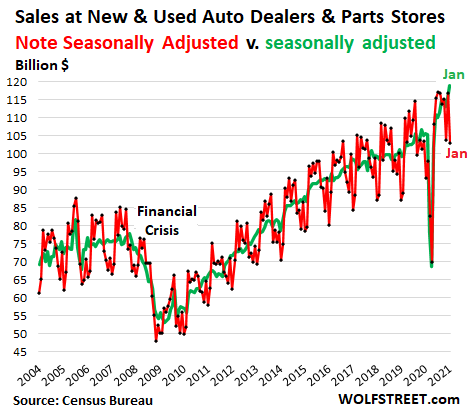
But wait…. these figures are not adjusted for inflation, and there have been and broad price increases in recent months in new and used vehicle retail sales, and these price increases were confirmed yesterday by the largest chain of auto dealerships in the US, AutoNation. And the year-over-year sales increase of 10.4% appears to be mostly accounted for by price increases of new and used vehicles – and not an increase in demand.
Sales at building materials, garden supply and equipment stores are subject the gigantic seasonal adjustments. In January, “not seasonally adjusted,” sales plunged 10.7% in January from December, to $32 billion. But “seasonally adjusted,” sales rose by 4.6%.
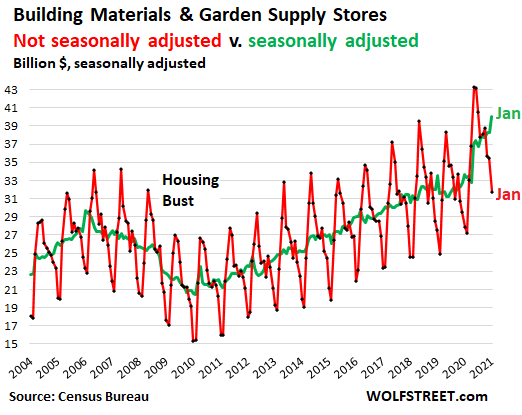
Sales at brick-and-mortar department stores have always been brutally seasonal, with enormous spikes in December, and drop-dead plunges in merchandise-return-January. Huge seasonal adjustments attempt to iron out those plunges and spikes.
Seasonally adjusted, sales soared 23.5% from December. But “not seasonally adjusted” sales plunged 41.6% from December to just $8.3 billion, the worst January and the third-worst month overall in the data going back to 1992 (does not include the thriving ecommerce sales of department stores; they’re included in ecommerce).
The fact that department store sales went from +23.5% “seasonally adjusted” to -41.6% “not seasonally adjusted” indicates just how ridiculously huge the adjustments were to smoothing this out.
From January 2001 to January 2021, sales have collapsed by 45% despite 20 years of population growth and inflation. As you can see from the chart, there is zero hope for brick-and-mortar department stores. Their business model has been obviated by ecommerce:
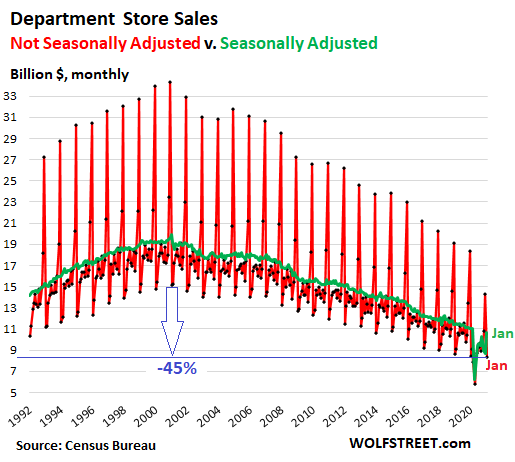
To avoid further vertigo, the we will stick to “seasonally adjusted” data below.
Sales at Food and Beverage Stores rose by 2.4% in January from December to $72 billion (seasonally adjusted) and were up 11.8% from a year ago. Work from home and restaurant restrictions continue to shift consumption to the home from restaurants, cafés, cafeterias, office vending machines, office supply closets, business trips, and vacations:
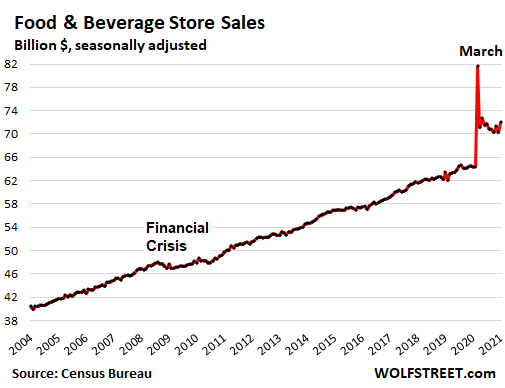
Sales at Restaurants & Bars rose 6.9% in January from December to $55 billion (seasonally adjusted), roughly in the same range since July. This was down 16.9% year-over-year:
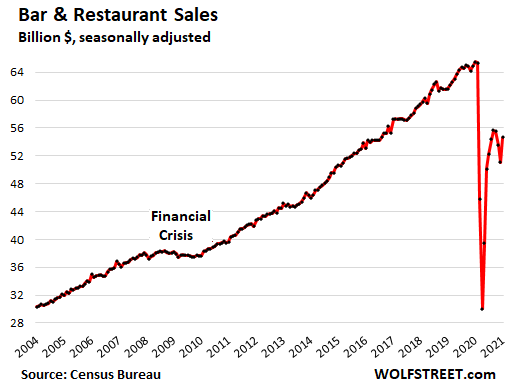
Sales at general merchandise stores (minus department stores) rose 2.5% in January from December, to $53 billion, and were up 8.0% from a year ago. This includes the brick-and-mortar stores of Walmart, Costco, and Target, but not their ecommerce sales:
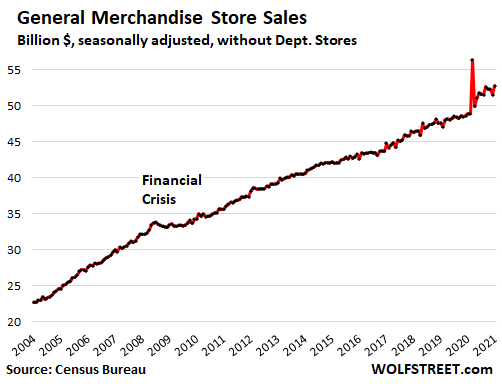
Sales at clothing and accessory stores rose 5.0% in January from December, to $20 billion (seasonally adjusted), but were down 11% year-over-year. Despite 13 years of population growth and inflation, sales are up only 7% from 2007 levels, with growth having shifted to ecommerce:
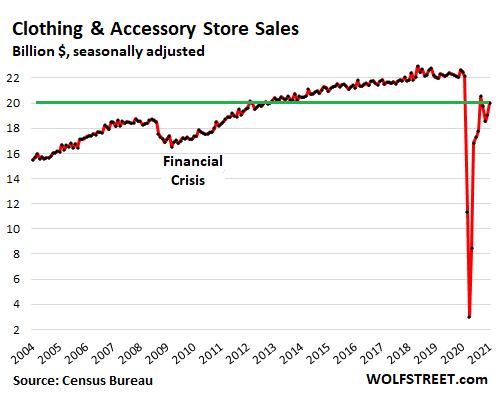
Sales at sporting goods, hobby, book and music stores jumped 8.0% in January from December, to $8.2 billion (seasonally adjusted), and by 22.5% year-over-year:
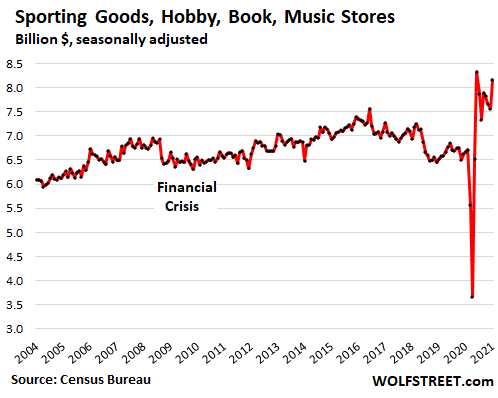
Sales at furniture and home furnishing stores jumped 12.0% in January from December, to $11 billion (seasonally adjusted), and 11.7% year-over-year.
To get back to the theme of seasonal adjustments and how huge they are in January: “not seasonally adjusted” sales plunged by 13% in January from December.
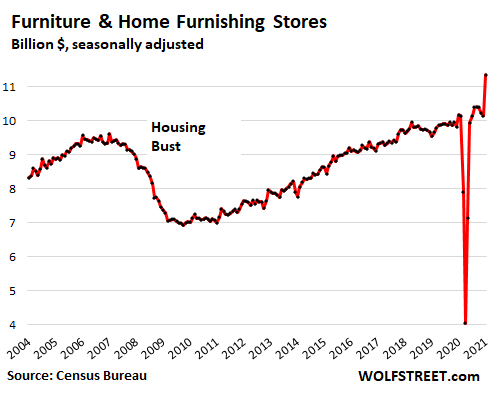
Sales at Electronics and appliance stores soared 14.7% in January from December, to $7.8 billion (seasonally adjusted), but were down 3.5% year-over-year.
Alas, “not seasonally adjusted,” sales plunged by 27% month-over-month. Going from +14.7% “seasonally adjusted” to -27% “not seasonally adjusted” implies a mega-ton of seasonal adjustments, and even small shifts cause the results to go awry in a large way:
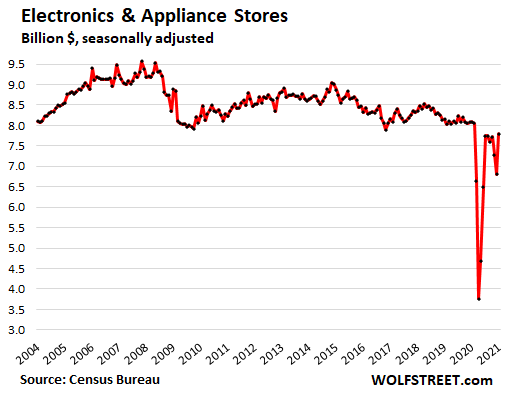
January is the worst month to draw conclusions on retail sales due to the seasonal plunge in sales from the surge in December, and due to the massive seasonal adjustments used to somehow iron out that plunge. The seasonal adjustments are much smaller for the rest of the year.
December had already been strong based on not-seasonally adjusted data, and sales in January were seasonally a lot lower, as they should be, but indicated a solid follow-up on the strong December. But the seasonal adjustments in both months went awry, showing December and the prior two months as way too weak and January as way too strong. And the $600 stimulus checks may have added a little oomph to the seasonal adjustments gone awry.
Enjoy reading WOLF STREET and want to support it? You can donate. I appreciate it immensely. Click on the mug to find out how:
![]()


There were some good deals during the holidays, but January was great for sales. I scored some nice items, really discounted, in January.
People sure come in different flavors. I haven’t been much of a consumer in 15 years. I buy so little I am rusty in my shopping habits. I am a functional person, so if it works I don’t replace it even if it’s out of style because when you are an old guy you kind of take pride in that persona.
It’s called “sustainability”. Dont’ dump working stuff, and repair when broken.
I adhere to the same principles. The laptop I am currently ising is 10 years old. Replaced the hard disc with an SSD, works just fine. Screen went? Bought an inexpensive external one, job done.
Same for the car. Driving an 11 year old 6 cyl 3 liter BMW diesel. It might outlive me. At 65 ( nautical) mph, it makes 1800 rpm’s. It will work forever.
That fits my lifestyle too, and I still maintain my cars myself at 77 years old. My daughter says there will be a special place in Heaven for guys like us. LOL!
I had a 2008 BMW that I got rid of 2 years ago. The engine was in great shape, but everything else broke all the time. I used to joke that the dealership had a $500 cover charge. It was hard to find anyone else that would work on it, and it was impossible to do the work myself.
Instead, I bought a Porsche that was already 10 years old but with low miles, and it’s run great. I’ve even been able to do some minor repairs myself.
They’re making things like your behavior harder and harder.
I’m in the IT space. More and computers are becoming disposable and they are using lies to force people to buy new. There are several ways they are doing this, but the main one is by preventing certain software from running on anything but the latest NSA-certified OS release; Said same OS prevented from running on anything but a new computer. Soon they will lock the Internet to only sites with “valid” SSL certificates. i.e. only sites in the good graces of the tyranny and so have not had their SSL-certificate revoked. Those site will in turn only be visible to users with the latest Web browsers running on only the latest hardware and OSes, etc. If you thought censorship was bad in 2020…
As for older cars: Slowly they are planning or implementing ever higher taxes on older “polluting,” “____Insert Scam Word Here____” vehicles.
I could go on, but such behavior of yours is slowly going to be outlawed in various ways for all of us.
@ Brad
I work in cybersecurity. There are very good, non-tinfoil hat reasons for everything you said about outdated OS’s and TLS implementations. I don’t have the time to address everything. If they shut down a CA like Lets Encrypt then maybe you have a point but as it stands, what you wrote is just crazy talk. I’m honestly curious what you do in IT lol
Post holidays shopping gets you even greater discounts because they are trying to get rid of stuff. Some stores, when people still bought at stores, sometimes did the huge discount as early as the second day of the year because they had to get rid of all the toys and Christmas items they didn’t sell during December to make room for different stuff.
In other words, they are lying through their teeth. All data massaged to make everything look good. At least we have people like you who are smart enough to expose the lies.
Seasonally adjusted profits should be good!
If Trump were in office, the Deep State would have the seasonal adjustment in the negative
We’re all AI bots controlled by the NSA anyway. Thanks DARPA! :D
The pot calling the kettle black. Trump would be out saying how great things are and driving the market up 1000 points each day. Just how many hundreds of times did Trump use his fake China deal, fake stimulus checks coming, and fake vaccine to drive the stock market up like there was no tomorrow. Without his fakery, S&P would at best be at 2300.
It was a great ride if you cashed out in December! Or even in January for that matter. Now it’s up to the “new” old gang to keep the facade going.
I thank Trump for the fake vaccine that I just received!
It looks like for many life is going back to normal. For others they face a new normal with changes. Life goes on as always.
Not even enough for a single full charge of your Tesla in Texas right now…!
“And the $600 stimulus checks may have added a little oomph to the seasonal adjustments gone awry.”
Yeah, the handful of Tesla owners among the 29,000 Griddy customers maybe. The rest of the 29 million Texans are paying the same rate as before, and if they have power, which many don’t, they could in theory charge their Tesla for the same rate as before.
Some of them are sleeping in their Teslas because that’s the only place they have that has heat and power.
Comfy? Ever slept in a car?
As a NYer, the common experience is sleeping in an apt with no heat, it is brutal. I remember sleeping with my clothes and coat on for days. The other common experience is heating water on a gas stove to wash up. I have a system for that I learned from being a NYer.
This new crisis in Texas is a godsend for Musk.
Musk announced new price cuts for Model 3 and Y cars last night. Trouble is brewing. Could be his new way to make money is Bitcoin?
Using the heat…in a Tesla…in winter…
Maybe you got an hour.
Do some research on this.
Perhaps more investments in battery power plants is the way to go in Texas. I figure it could help the grid in the winter and summer.
They say Fire Ants die at under 10 degrees. So, there might be something positive about this cold snap in Texas. The cold might help with the Florida Boas and Iguanas too.
Prices are up and power companies are making plenty of money, why would they invest in batteries?
A more stable power grid only benefits the consumer.
We pay $.09 KWh to our highly regulated public utility for electricity, industrial users less.
From Reuters: Millions of Texans are without power after grid operator The Electric Reliability Council of Texas (ERCOT) instituted blackouts as electric heating demand overwhelmed generation, some of which was knocked offline by the extreme weather.
Next-day power for Wednesday at the ERCOT North hub, which includes the cities of Dallas and Fort Worth, spiked to a record of $8,800 per MWh, a nearly six-fold jump from $1,489.75 the previous day.
Gotta love the tenacious arguments about how wonderful profit generating free enterprise (pun intended) is the only way to go for utilities. One ex pol even stated Texans would gladly do without power for a few days to ensure no one tells them what to do. I just have one question? Where are all the comments from the flee people, who moved to Texas from evil CA?
Strangely silent this week on that topic.
Paulo,
The Texas debacle looks like an Enron 2.0 scandal to me. I expect our friends on Wall St. made a bundle. Who knew.
Not even a bit cold in tpa bay area this morning ra, but we can at least hope!
Might be some other way now, but for decades past, the only way to actually kill fire ants was to pour a mix of gas and diesel slowly into the nest and ignite.
Other than that, the queen got away from any and all chemical treatments and popped up sometimes hundreds of yards away.
During zero temps, they would just go a bit deeper for a while, then come right back up.
And man, do they bite, eh?
Heard they are worse than peeing on the electric fence??
I have stepped on a fire ant hill and didn’t know it when at an oil producing site a few years ago. The little bastards ran up my legs under my Frac coveralls. Once the biting started, I ripped off my coveralls and had a real time getting them off me. It;s takes a couple of days for the itching and puss to form (after the initial sting). Not fun.
The fire ants were not even phased by this cold snap here. They will be back! This insect alone should be a deterrent for Californians from relocating here. We have scorpions too!
Shrimp and grits here.
Soon to be back in the deep freeze. Caught enough fish for
Fish fry and old fashions on Friday.
I’ve been getting fast food coupons in mails recently and noticed a huge jump compare to previous years… 10~15% increase if I remember correctly. It’s insane, not sure how much of it to do with inflation, and how much of it just them trying to raise the cost to even the lower number of sales.
Increases in minimum wage.
wrong, nice try though
We are loving the coupons as retirees.
Cheap night out (and breakfast too)!. The only problem is that we don’t get the newspaper anymore (cost too much) and that’s where the coupons are. So I have to walk the dog in the early morning to find newspapers on driveways and lift out the coupons or have friends save them for me. I’ve never got them in the mail.
I just found out recently that certain “dining locations” have apps that contain the coupons. But this doesn’t work well with a 12 year old flip phone.
There are coupon websites where you can download the coupons. Some are free some are subscription.
Now is the time to go short, the move is over, sure 2% more could come but is it worth it…thanks Biotech technical charts and flu fears….I would make most wall street advisors look bad with my return…
where is the news on how the capitol policeman didn’t die from blunt force trauma. I look forward to the impeachment of all the liberals that bailed out rioters last summer…..its time to purge these sheep flockers
I listened to Cathy Wood of Arc Hedge Funds in their podcast. It’s interesting in their view of the world that tech is going to swallow up nearly the whole world of companies that have cash flow and not dumping money back into technology. It gets you thinking that she could be right, but I am not smart enough to know.
Since LBOs became popular in the 1980s, it’s been downhill all the way, for the target companies. All those mergers have resulted in degraded companies selling degraded products. All this maximizing of shareholder value has hollowed out the country and the companies.
When China starts selling good quality goods, American companies will hit the proverbial great wall.
“its time to purge these sheep flockers”
go ahead, lead the charge buddy
Why can’t you guys understand that is not the same thing!? Although they went about it wrong in many cases those rioters were fighting back against actual injustice while everything Trump was doing was a lie…like the last 4 years.
Seasonally adjusted versus sales is the same as figures don’t lie but liars can figure.
Thank you for explaining all of this Wolf.
So, why is the room still spinning?
The pain hasn’t hit yet wait until stimulus checks stop what happened to conservetim went to grandma’s farm as child no heat in bedroom s Nebraska weather in winter people are like cattle follow the leader no wonder 90 percent are broke there own making quit buying none essential junk can’t fix stupid
Seems like consumers will consume electronics when the free money stops, idk how much else though. Trending towards peak capitalism monopolies with Amazon asn Google. Reminds me of US Steel and JP Morgan. Funny how it goes, almost exactly 100 years since the last great depression.
Thanks for the analysis Wolf. It’s very eye opening. One thing sticks out is that some part of the population really likes to shop at stores like Walmart, Target, etc. I can understand that when guys like myself get stiffed on a delivery from any online retailer, no matter what the reason, I then use a B&M store the next time I need that stuff. We tried buying food items from Amazon online and that turned out to be a disaster.
Incidentally, our Amazon purchases are dropping off, percentage wise, on a yearly basis, and we have been buying from them since 1998 (books first). Maybe it’s also because we are getting so old (LOL).
Now I know there always will be a subset of the population that can’t or won’t buy online and that should help to keep B&M stores in business, whichever ones survive.
Walmart was open yesterday, the first day after the “great freeze” here in Houston, and it was packed. I went there to pick up a prescription, which was filled yesterday. Home Depot and Lowe’s was open too, and there were big sales on PVC pipe and fittings….LOL!
Texas is pretty resilient and we will live through this and get back to heat and high humidity as it’s our preconditioning for most of us going to Hell for burning up all these God gifted hydrocarbons. The fire ants will also survive this event too.
Can’t remember when it cost more to build a new house. Just within the last year, lumber price futures have gone from $260 to $992. Other commodity prices, of materials needed for building, have been jacked up too. The prices for materials shipped in from China are reflecting the runaway shipping price increases. The prices for sub-contractor compensation have also jumped.
I know very few builders who will build anything for themselves, but will build for potential buyers without reservation. No matter how much it costs them to build, they will still build in their profit margins and still will have buyers fighting over the finished spec houses. If they are building for clients, then it is on a cost plus basis, and the costs are going up dramatically. Folks want single family houses, and price no longer appears to be an obstacle.
As Wolf has mentioned in the past, mortgage relief also boosted other consumption. When the next back swan hits, people will have learned that mortgages payments are expendable but consumption may soar otherwise. Now that’s UBI we can believe in !
I don’t think mortgage payment is coming back for next 2 year or so, and so are rent payments.
+23.5% “seasonally adjusted” to -41.6% “not seasonally adjusted”
Wolf does a lot of valuable work, but I quit reading after he demonstrated that it was all detailed analysis of lies.
Why does anyone even bother with comparing month to month? Employs lots of analysts and gives folks something to write about I guess.
Comparing months year to year has meaning if adjusted for inflation, but the government can’t even get that right. I got a whole $19 raise in my social security, woohoo!
Americans are so screwed. Minuscule raise for federal employees, military and retirees, and not a peep from anyone. It sucks to be somebody who depends on that for living expenses.
I expatriated to Ecuador 11 years ago, and for the last 5 years we have been banking one of our social security checks at least 10 months per year. Medical expenses are 10-15% of USA prices so we self insured for 10 years. A nice 2 bedroom apartment rents for $350. If you buy $40 in food at the outdoor Sunday market, it takes two people to carry it out.
“I got a whole $19 raise in my social security, woohoo!”
The entire point of the 1995 Boskin Commission was to come up with a “more accurate” CPI in order to reduce fedgov COLA payments. Hello hedonics and substitution. Isn’t funny how “discovered inaccuracies” are always in the direction which favors the fedgov goal.
But about Social Security specifically, it’s effectively a Ponzi Scheme anyway.
The problem with social security is that it hasn’t been age-adjusted. When social security was initially implemented the life expectancy for Americans was 62. The only people receiving benefits at the time were the disabled and those out-living the normal life. Since then health has improved and the life expectancy is somewhere around 78 but we are just now slowly moving the age for receiving to 67.
It was not set up to be a retirement plan.
Social plans are great when they serve a specific purpose but they tend to grow over time and definitely never shrink.
Winston
Just like the stock market….and virtually every financial instrument in existence.
I have never understood why, like in business, the Government doesn’t just use a Moving Annual Total (MAT) instead of the much more confusing, and subject to manipulation, “seasonal adjustments”? An MAT automatically adjusts for seasonality so needs no further adjustment.
philipat,
Yes. What some people want to see are turning points, and in a timely fashion. In theory, month to month would do that. But in retail, the seasonal variations create so much noise, that month-to-month becomes meaningless. Year-over-year is good, but might also miss turning points. The MAT as you call it, or the 12-month moving average (12MMA) as I call it, is good, but it waters down turning points that take three or four months to show up.
I think seasonal adjustments are the worst. It’s better to sort through the noise and figure out what is going on. But as you can tell from the charts, it’s complicated, and the media cannot sell a story like that – and I can’t either :-]